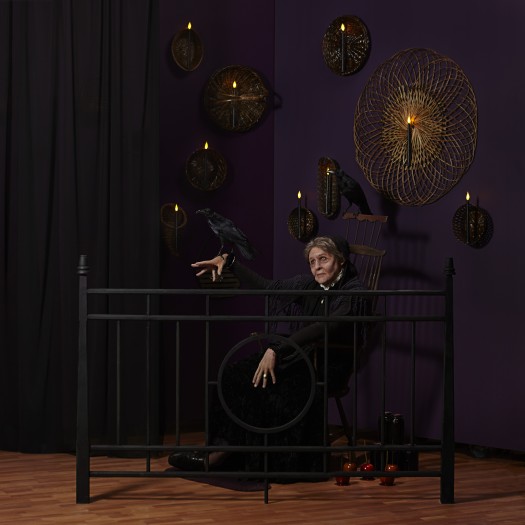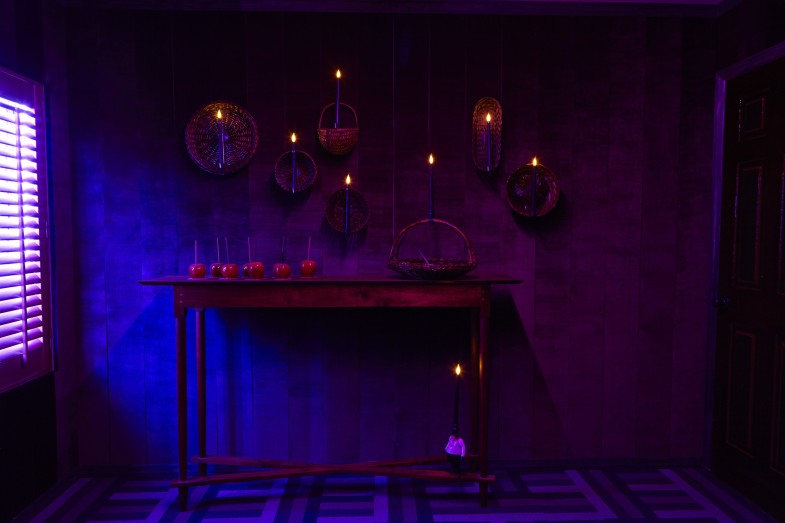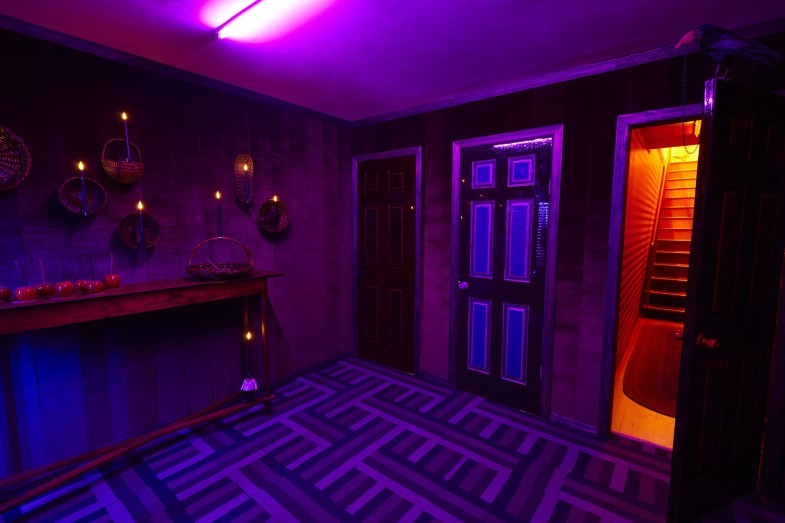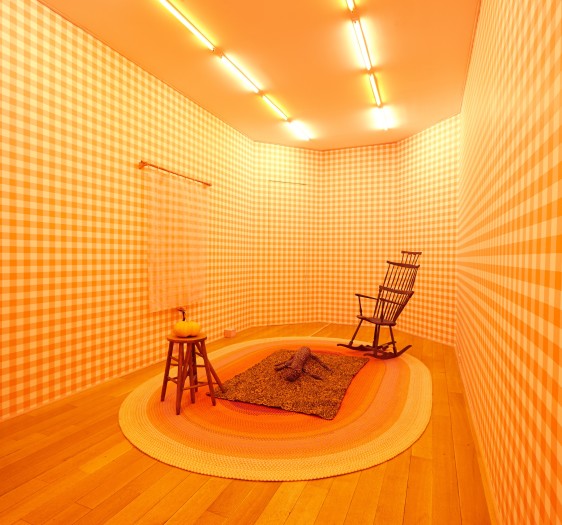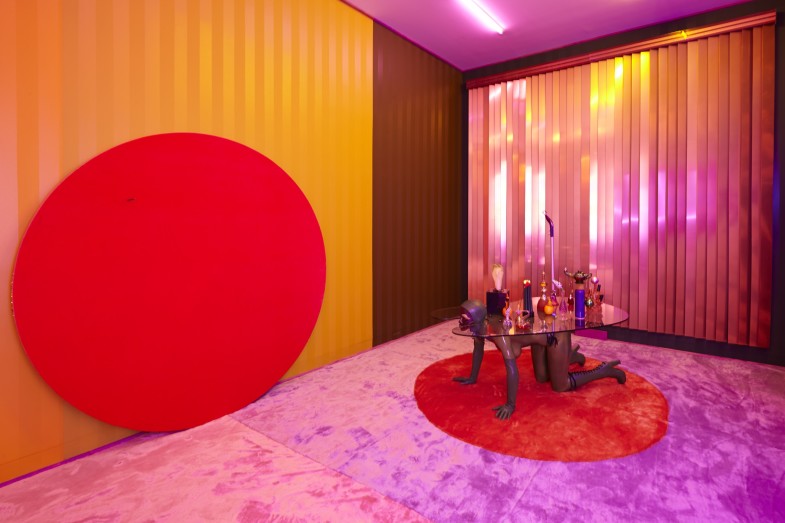Luxembourg & Dayan will present Die Hexe, a solo exhibition by Alex Da Corte. For Die Hexe (“The Witch” in German), Da Corte has created a site-specific installation that consumes the gallery’s East 77th Street townhouse, turning it into an implausible cross between a dollhouse and a haunted house. Here visitors will take on a journey through familiar imagery and obscure biographical references that mingle, repeat, trade places, and morph into new provocations that invite reflections upon memory, impulse, the stability of knowledge, and what constitutes value in a work of art.
Da Corte’s largest installation to date, Die Hexe will remain on view through April 11th, 2015. The exhibition will introduce a broader audience to the work of an admired Philadelphia-based artist whose first major museum solo exhibition will open at Massachusetts Museum of Contemporary Art (Mass MoCA) in March 2016.
Die Hexe is accompanied by a fully illustrated catalogue featuring a text by Da Corte and a new essay by William Pym.
From the moment they cross the threshold of Luxembourg & Dayan into Die Hexe, visitors will find themselves confronted by a series of vignettes that unfold sequentially like scenes in a movie, proceeding from one gallery space to the next, from one floor to another. These “sets” correspond roughly to the familiar themes and functions of domestic rooms. In each mise en scene along the way, Da Corte has embedded an artwork by another artist who serves him as foil or father figure. Sculptures by Robert Gober, Mike Kelley, Bjarne Melgaard, and Haim Steinbach thus appear out of context like unannounced guests, familiar yet estranged. Through Da Corte’s deliberate placement, these iconic works of art – all originally intended by their makers to question modes of presentation, among other things – are subjected to a strange rebirth.
Disruptions of authorship and interrogations of an artwork’s unique aura have long been facets of Da Corte’s artistic practice. In Die Hexe, these fascinations are also linked to the unique attributes of the gallery’s wider program. Thinking about Luxembourg & Dayan’s role as a platform for the re-evaluation of historical works of art (particularly under-recognized but pivotal postwar European painting and sculpture), Da Corte was prompted to adopt a similar conceptual framework, studying the very notion of re-evaluating something considered “valuable”. Consequently, Die Hexe suggests a series of Duchampian questions about art’s ability to maintain its life force when removed from an originally intended context
Da Corte also was inspired by the history of Luxembourg & Dayan’s building. He learned that past tenants of the townhouse included the two men and two women who comprised The Mamas and The Papas, among the most famous American bands of the 1960s, who, according to rumor, sequestered themselves in the house to create one of their most important albums. This lore precipitated an interrogation into the influence of Da Corte’s ancestors—both his “conceptual forefathers” in art and the two couples who were his biological grandparents. Such free association and intertwining of narratives gives Die Hexe a distinct sense of contingency and continuation.
Da Corte’s installations are known for adopting the artificiality and glossy, detached aesthetics of commerce and advertising; they draw equally upon his recollections and biography. Thus Die Hexeinterweaves disconnected snippets of memory within its hermetic surroundings, even while rejecting nostalgia. For example, a pantry smelling of spices and filled with anonymous products harkens back to the artist's very personal relationship to the retail landscape of grocery stores: Both of Da Corte’s grandfathers worked along the food supply chain, albeit at opposite ends. One grandfather opened Venezuela’s first modern supermarket, which over time spawned a conglomerate, while the other grandfather worked simultaneously as a supermarket shelf stocker in New Jersey. Elsewhere in the exhibition, Da Corte grafts elements of his grandmother’s house onto the gallery’s surroundings, with craft-based décor such as woven rugs, quilt patterns, and wreathes signaling this transference.
Drawing the visitor through scenes that suggest an array of states, from fear and anger, to amusement and lust, to morbid contemplation, Die Hexe traces a cycle of emotions, while broaching questions of memory and biography, consumerism, American culture, folklore and the history of art. Pockets of experience are visited and revisited; ghost replicas of works of art are introduced; and the end mirrors a beginning that returns to haunt us.
About The Artist
Alex Da Corte (b. 1980) lives and works in Philadelphia. He received his BFA from The University of the Arts, Philadelphia, and his MFA from Yale University, New Haven, in 2010. He has recently had solo exhibitions at the Institute of Contemporary Art, Philadelphia (2014; together with Jayson Musson), Carl Kostyal, Stockholm (2014), White Cube, London (2014), David Risley, Copenhagen (2014), the Institute of Contemporary Art, Maine (2013), Oko, New York (2013; together with Borna Sammak) and the Institute of Contemporary Art, Philadelphia (2012). His work was included in numerous group exhibitions in venues that include The Museum of Modern art, New York; The Studio Museum in Harlem, New York; Contemporary Art Museum, St. Louis; Zach Feuer Gallery, New York; Mitchell-Innes & Nash, New York; Team Gallery, New York; Yvon Lambert, New York.

